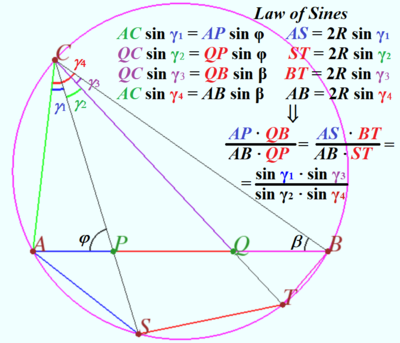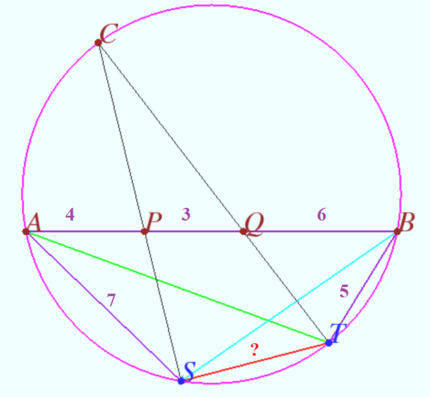Difference between revisions of "2016 AIME II Problems/Problem 10"
m (→Solution 2 (Projective Geometry)) |
|||
| (16 intermediate revisions by 5 users not shown) | |||
| Line 3: | Line 3: | ||
| − | ==Solution | + | ==Solution 1== |
<asy> | <asy> | ||
import cse5; | import cse5; | ||
| Line 40: | Line 40: | ||
Edit: Note that the finish is much simpler. Once you get <math>\dfrac{AS}{\sin\alpha}=\dfrac{ST}{\sin\beta}</math>, you can solve quickly from there getting <math>ST=\dfrac{AS \sin(\beta)}{\sin(\alpha)}=7\cdot \dfrac{15}{24}=\dfrac{35}{8}</math>. | Edit: Note that the finish is much simpler. Once you get <math>\dfrac{AS}{\sin\alpha}=\dfrac{ST}{\sin\beta}</math>, you can solve quickly from there getting <math>ST=\dfrac{AS \sin(\beta)}{\sin(\alpha)}=7\cdot \dfrac{15}{24}=\dfrac{35}{8}</math>. | ||
| − | ==Solution | + | ==Solution 2 (Projective Geometry)== |
| − | Projecting through <math>C</math> we have <cmath>\frac{3}{4}\times \frac{13}{6}=(A,Q;P,B)\stackrel{C}{=}(A,T;S,B)=\frac{ST}{7}\times \frac{13}{5}</cmath> which easily gives <math>ST=\frac{35}{8}\Longrightarrow 35+8=\boxed{ | + | [[File:2016 AIME II 10c.png|400px|right]] |
| + | Projecting through <math>C</math> we have <cmath>\frac{3}{4}\times \frac{13}{6}=(A,Q;P,B)\stackrel{C}{=}(A,T;S,B)=\frac{ST}{7}\times \frac{13}{5}</cmath> which easily gives <math>ST=\frac{35}{8}\Longrightarrow 35+8=\boxed{043}</math>. | ||
| − | ==Solution | + | ==Solution 3== |
By Ptolemy's Theorem applied to quadrilateral <math>ASTB</math>, we find | By Ptolemy's Theorem applied to quadrilateral <math>ASTB</math>, we find | ||
<cmath>5\cdot 7+13\cdot ST=AT\cdot BS.</cmath> | <cmath>5\cdot 7+13\cdot ST=AT\cdot BS.</cmath> | ||
| Line 69: | Line 70: | ||
<cmath>\begin{align*}35+13ST&=\frac{21\cdot 35}{8}\\13ST&=\frac{13\cdot 35}{8}\\ST&=\frac{35}{8}.\end{align*}</cmath> | <cmath>\begin{align*}35+13ST&=\frac{21\cdot 35}{8}\\13ST&=\frac{13\cdot 35}{8}\\ST&=\frac{35}{8}.\end{align*}</cmath> | ||
Thus the answer is <math>\boxed{43}</math>. | Thus the answer is <math>\boxed{43}</math>. | ||
| + | |||
| + | ==Solution 4 == | ||
| + | Extend <math>\overline{AB}</math> past <math>B</math> to point <math>X</math> so that <math>CPTX</math> is cyclic. Then, by Power of a Point on <math>CPTX</math>, <math>(CQ)(QT) = (PQ)(QX)</math>. By Power of a Point on <math>CATB</math>, <math>(CQ)(QT) = (AQ)(QB) = 42</math>. Thus, <math>(PQ)(QX) = 42</math>, so <math>BX = 8</math>. | ||
| + | |||
| + | By the Inscribed Angle Theorem on <math>CPTX</math>, <math>\angle SCT = \angle BXT</math>. By the Inscribed Angle Theorem on <math>ASTC</math>, <math>\angle SCT = \angle SAT</math>, so <math>\angle BXT = \angle SAT</math>. Since <math>ASTB</math> is cyclic, <math>\angle AST = \angle TBX</math>. Thus, <math>\triangle AST \sim \triangle XBT</math>, so <math>AS/XB = ST/BT</math>. Solving for <math>ST</math> yields <math>ST = \frac{35}{8}</math>, for a final answer of <math>35+8 = \boxed{043}</math>. | ||
| + | |||
| + | ~ Leo.Euler | ||
| + | |||
| + | ==Solution 5 (5 = 2 + 3)== | ||
| + | [[File:2016 AIME II 10.png|430px|right]] | ||
| + | By Ptolemy's Theorem applied to quadrilateral <math>ASTB</math>, we find | ||
| + | <cmath>AS\cdot BT+AB\cdot ST=AT\cdot BS.</cmath> | ||
| + | Projecting through <math>C</math> we have | ||
| + | <cmath>\frac{AQ \cdot PB}{PQ \cdot AB} = (A,Q; P,B)\stackrel{C}{=}(A,T; S,B)=\frac{AT \cdot BS}{ST \cdot AB}. </cmath> | ||
| + | Therefore <cmath>AT \cdot BS = \frac {AQ \cdot PB}{PQ} \times ST \implies</cmath> | ||
| + | <cmath>\left(\frac {AQ \cdot PB}{PQ} - AB\right)\times ST = AS \cdot BT \implies</cmath> | ||
| + | <cmath>ST = \frac {AS \cdot BT \cdot PQ}{AQ \cdot PB – AB \cdot PQ}</cmath> | ||
| + | <cmath>ST = \frac {7\cdot 5 \cdot 3}{7\cdot 9 – 13 \cdot 3 } = \frac {35}{8} \implies 35 + 8 = \boxed {43}.</cmath> | ||
| + | |||
| + | '''vladimir.shelomovskii@gmail.com, vvsss''' | ||
| + | |||
| + | ==Solution 6== | ||
| + | |||
| + | Connect <math>AT</math> and <math>\angle{SCT}=\angle{SAT}, \angle{ACS}=\angle{ATS}, \frac{ST}{\sin \angle{SAT}}=\frac{AS}{\sin \angle{ATS}}</math> | ||
| + | |||
| + | So we need to get the ratio of <math>\frac{\sin \angle{ACS}}{\sin \angle{SCT}}</math> | ||
| + | |||
| + | By clear observation <math>\triangle{CAQ}\sim \triangle{BTQ}</math>, we have <math>\frac{CQ}{AC}=\frac{6}{5}</math>, LOS tells <math>\frac{AC}{\sin \angle{CPA}}=\frac{4}{\sin \angle{ACS}}; \frac{CQ}{\sin \angle{CPQ}}=\frac{3}{\sin \angle{PCQ}}</math> so we get <math>\frac{\sin \angle{PCQ}}{\sin \angle{ACS}}=\frac{5}{8}</math>, the desired answer is <math>7\cdot \frac{\sin \angle{SAT}}{\sin \angle{ATS}}=\frac{35}{8}</math> leads to <math>\boxed{043}</math> | ||
| + | |||
| + | ~blusoul | ||
== See also == | == See also == | ||
{{AIME box|year=2016|n=II|num-b=9|num-a=11}} | {{AIME box|year=2016|n=II|num-b=9|num-a=11}} | ||
{{MAA Notice}} | {{MAA Notice}} | ||
Latest revision as of 21:09, 31 January 2024
Contents
Problem
Triangle ![]() is inscribed in circle
is inscribed in circle ![]() . Points
. Points ![]() and
and ![]() are on side
are on side ![]() with
with ![]() . Rays
. Rays ![]() and
and ![]() meet
meet ![]() again at
again at ![]() and
and ![]() (other than
(other than ![]() ), respectively. If
), respectively. If ![]() and
and ![]() , then
, then ![]() , where
, where ![]() and
and ![]() are relatively prime positive integers. Find
are relatively prime positive integers. Find ![]() .
.
Solution 1
![[asy] import cse5; pathpen = black; pointpen = black; pointfontsize = 9; size(8cm); pair A = origin, B = (13,0), P = (4,0), Q = (7,0), T = B + 5 dir(220), C = IP(circumcircle(A,B,T),Line(T,Q,-0.1,10)), S = IP(circumcircle(A,B,C),Line(C,P,-0.1,10)); Drawing(A--B--C--cycle); D(circumcircle(A,B,C),rgb(0,0.6,1)); DrawPathArray(C--S^^C--T,rgb(1,0.4,0.1)); DrawPathArray(A--S^^B--T,rgb(0,0.4,0)); D(S--T,rgb(1,0.2,0.4)); D("A",A,dir(215)); D("B",B,dir(330)); D("P",P,dir(240)); D("Q",Q,dir(240)); D("T",T,dir(290)); D("C",C,dir(120)); D("S",S,dir(250)); MP("4",(A+P)/2,dir(90)); MP("3",(P+Q)/2,dir(90)); MP("6",(Q+B)/2,dir(90)); MP("5",(B+T)/2,dir(140)); MP("7",(A+S)/2,dir(40)); [/asy]](http://latex.artofproblemsolving.com/f/6/0/f603df291461fa6afd0563d94abdc2644aeb97ec.png) Let
Let ![]() ,
, ![]() , and
, and ![]() . Note that since
. Note that since ![]() we have
we have ![]() , so by the Ratio Lemma
, so by the Ratio Lemma ![]() Similarly, we can deduce
Similarly, we can deduce ![]() and hence
and hence ![]() .
.
Now Law of Sines on ![]() ,
, ![]() , and
, and ![]() yields
yields ![]() Hence
Hence ![]() so
so ![]() Hence
Hence ![]() and the requested answer is
and the requested answer is ![]() .
.
Edit: Note that the finish is much simpler. Once you get ![]() , you can solve quickly from there getting
, you can solve quickly from there getting ![]() .
.
Solution 2 (Projective Geometry)
Projecting through ![]() we have
we have ![]() which easily gives
which easily gives ![]() .
.
Solution 3
By Ptolemy's Theorem applied to quadrilateral ![]() , we find
, we find
![]() Therefore, in order to find
Therefore, in order to find ![]() , it suffices to find
, it suffices to find ![]() . We do this using similar triangles, which can be found by using Power of a Point theorem.
. We do this using similar triangles, which can be found by using Power of a Point theorem.
As ![]() , we find
, we find
![]() Therefore,
Therefore, ![]() .
.
As ![]() , we find
, we find
![]() Therefore,
Therefore, ![]() .
.
As ![]() , we find
, we find
![]() Therefore,
Therefore, ![]() .
.
As ![]() , we find
, we find
![]() Therefore,
Therefore, ![]() . Thus we find
. Thus we find
![]() But now we can substitute in our previously found values for
But now we can substitute in our previously found values for ![]() and
and ![]() , finding
, finding
![]() Substituting this into our original expression from Ptolemy's Theorem, we find
Substituting this into our original expression from Ptolemy's Theorem, we find
 Thus the answer is
Thus the answer is ![]() .
.
Solution 4
Extend ![]() past
past ![]() to point
to point ![]() so that
so that ![]() is cyclic. Then, by Power of a Point on
is cyclic. Then, by Power of a Point on ![]() ,
, ![]() . By Power of a Point on
. By Power of a Point on ![]() ,
, ![]() . Thus,
. Thus, ![]() , so
, so ![]() .
.
By the Inscribed Angle Theorem on ![]() ,
, ![]() . By the Inscribed Angle Theorem on
. By the Inscribed Angle Theorem on ![]() ,
, ![]() , so
, so ![]() . Since
. Since ![]() is cyclic,
is cyclic, ![]() . Thus,
. Thus, ![]() , so
, so ![]() . Solving for
. Solving for ![]() yields
yields ![]() , for a final answer of
, for a final answer of ![]() .
.
~ Leo.Euler
Solution 5 (5 = 2 + 3)
By Ptolemy's Theorem applied to quadrilateral ![]() , we find
, we find
![]() Projecting through
Projecting through ![]() we have
we have
![]() Therefore
Therefore ![]()
![]()
![]()
![]()
vladimir.shelomovskii@gmail.com, vvsss
Solution 6
Connect ![]() and
and ![]()
So we need to get the ratio of ![]()
By clear observation ![]() , we have
, we have ![]() , LOS tells
, LOS tells ![]() so we get
so we get ![]() , the desired answer is
, the desired answer is ![]() leads to
leads to ![]()
~blusoul
See also
| 2016 AIME II (Problems • Answer Key • Resources) | ||
| Preceded by Problem 9 |
Followed by Problem 11 | |
| 1 • 2 • 3 • 4 • 5 • 6 • 7 • 8 • 9 • 10 • 11 • 12 • 13 • 14 • 15 | ||
| All AIME Problems and Solutions | ||
The problems on this page are copyrighted by the Mathematical Association of America's American Mathematics Competitions. 











